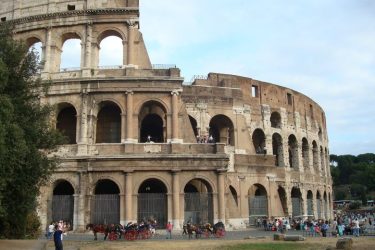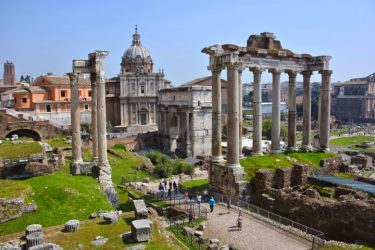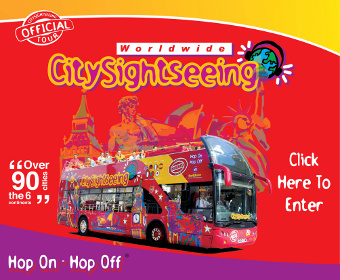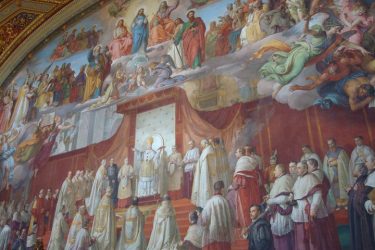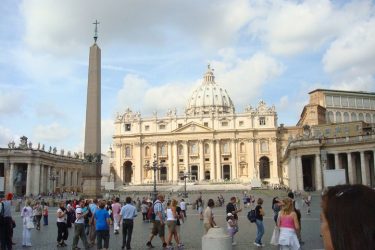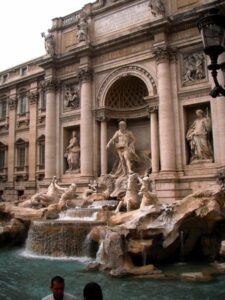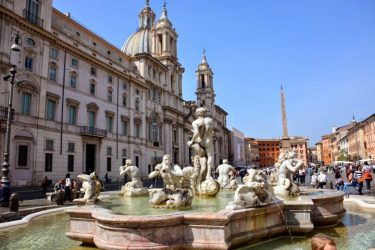Anyone with an interest in history, architecture, or culture should visit Rome. The Colosseum, the Pantheon, and the Vatican City are a few of the city’s most recognizable landmarks. Rome’s incredible history and aesthetic accomplishments are all around you, making it impossible to wander the city without being in awe of them.
The Vatican City is yet another famous landmark in Rome. The Vatican City, which serves as the residence of the Pope and the Catholic Church, is a must-see destination for anybody with an interest in religion, art, or history. The magnificent Sistine Chapel, Vatican Museums, and St. Peter’s Basilica are all open to visitors’ admiration.
The profusion of delectable food and drink is one of Rome’s best features. There are numerous possibilities to sample the regional cuisine, including gelato, wine, and classic pizza and pasta meals. The city’s food and beverage selections are sure to please, whether you are sitting in a sidewalk café or meandering through the old streets.
Aside from its historical and culinary charms, Rome is a fantastic place to go shopping, party, and enjoy the outdoors. There are many options available to fit your tastes, whether you’re seeking for fashionable clothing, regional crafts, or hip bars and clubs.
In this article, we will explore some of the top tourist attractions you should check out when you visit this beautiful city. Rome has something for everyone, whether they are into history, food, or the arts.
Visit the Colosseum in Rome
One of the most recognizable historic buildings in the world and a symbol of Rome is the Colosseum, also called the Flavian Amphitheatre. It was constructed between 70 and 80 AD, under the reigns of Vespasian and Titus, and had a capacity of 50,000 to 80,000 spectators.
Gladiator fights, animal hunts, and fictitious naval wars were just a few of the events held in the Colosseum. Emperors used these gatherings as a means of popularity and power projection in addition to providing entertainment for the Roman populace.
The Colosseum has sustained damage throughout the years as a result of both natural calamities and human activity, but it nevertheless stands as an example of Roman engineering and construction. It is now a well-liked tourist destination and a representation of Rome’s extensive past and vibrant present.
Visitors can tour the Colosseum today and discover its significance and history. The Colosseum is currently regarded as a wonder of ancient engineering and an intriguing piece of history, despite its tragic past.
2. Visit the Roman Forum
The Roman Forum, which housed numerous significant governmental structures as well as a bustling marketplace and public square, served as the hub of political and social activity in ancient Rome. Its history dates back to the seventh century BC, and it was located between the Capitoline and Palatine hills.
The Senate House, the Temple of Saturn, and the Arch of Titus are just a few of the significant buildings that have been erected in the Roman Forum over the years. Numerous well-known speeches, including those made by Julius Caesar and Mark Antony, were also delivered there.
Many of the Roman Forum’s structures were utilised as quarries for building materials during the Middle Ages when it was abandoned and allowed to deteriorate. Although it was later unearthed and excavated, it is now a well-liked tourist destination where people may explore the ruins of ancient Rome.
The Roman Forum is open to visitors, who can also learn about its significant past. It offers a window into the politics and everyday life of ancient Rome and is evidence of the city’s ongoing influence on Western civilization.
Hop on Hop Off Bus Tours in Rome
Hop on Hop Off bus tours in Rome are a well-liked and practical option for visitors to experience the numerous renowned attractions and landmarks of the city. With the ability to get out and explore places at their own pace before rejoining the tour, these trips give tourists the chance to move around the city on an open-top bus.
The buses normally go along a pre-planned route that makes stops at well-known tourist attractions like the Pantheon, Vatican City, and the Colosseum. Numerous languages are frequently offered for audio commentary, which offers explanations of the background and significance of each attraction.
The flexibility that a Hop on Hop Off bus tour provides is one of its key benefits. Visitors don’t have to worry about using public transportation or finding parking, and they can choose which sights to see and how long to spend at each destination.
Overall, Hop on Hop Off bus tours in Rome are a fantastic opportunity for visitors to explore the city’s many iconic landmarks while learning about its rich history and culture.
4. Visit the Pantheon
One of Rome’s oldest structures and best-preserved temples is the Pantheon, which dates back to the Roman Empire. Marcus Agrippa initially erected the temple in 27 BC as a devotion to all the Roman gods, but it was destroyed and rebuilt twice before Emperor Hadrian finished the present building in AD 125.
The Pantheon is well known for its spectacular dome, which, until recently, was the biggest unsupported dome in the world. The only source of illumination in the temple is natural light that enters through the oculus, a circular hole at the top of the dome, thanks to the dome’s design.
The Pantheon is now a well-liked tourist destination rather than being used for religious purposes. The elaborate marble floors and columns, as well as the temple’s extensive history and architectural wonders, are all open to visitors to examine. One of Rome’s most important and enduring icons, the Pantheon displays the ancient city’s engineering and architectural prowess.
5. Visit the Vatican Museums
One of the smallest autonomous nations in the world, Vatican City is home to the Vatican Museums, a collection of artwork and artefacts. The museums have a large collection of artwork, including tapestries, paintings, and sculptures from various historical eras.
Pope Julius II started gathering significant works of art and artefacts at the beginning of the 16th century, and he later built the museums. The Vatican Museums are currently one of the most well-liked tourist spots in Rome, drawing millions of people each year.
The Sistine Chapel, the centerpiece of the museum, is renowned for its breath-taking ceiling frescoes created by Michelangelo. Other well-liked sights are the Raphael Rooms, which exhibit the works of the Renaissance artist Raphael, and the Gallery of Maps, which has a variety of detailed maps and murals illustrating Italy’s regions.
In general, art and history enthusiasts should visit the Vatican Museums. By seeing priceless works of art and learning about the city’s rich history and culture, visitors can fully immerse themselves in Rome’s and the Vatican’s rich cultural heritage.
6. Visit the St. Peter’s Basilica in Rome
The largest church ever built dates back to the Renaissance and is situated in Vatican City, the world’s smallest sovereign state. Saint Peter, one of Jesus’ twelve apostles and often regarded as the first Bishop of Rome, is the name of the basilica.
The basilica is regarded as one of the greatest pieces of architecture in history and was created by several well-known Renaissance designers, including Michelangelo, Bramante, and Bernini. Rome’s skyline is dominated by the basilica’s enormous dome, which represents the city’s extensive cultural legacy.
Many significant works of art may be found inside St. Peter’s Basilica, including Michelangelo’s Pieta and Bernini’s Baldacchino, a huge bronze canopy that rests above the main altar. Additionally, visitors are welcome to tour the basilica’s numerous chapels and popes’ tombs, including those of St. Peter.
Overall, everyone with an interest in history, art, or architecture should make a trip to St. Peter’s Basilica. Its breath-taking beauty and extensive cultural legacy are proof of the long-lasting impact of Rome and the Vatican on Western culture.
7. Visit the Spanish Steps in Rome
One of Rome’s most well-known sites is the Spanish Steps, or Scalinata di Trinità dei Monti in Italian. The staircase, which was constructed in the 18th century, has 135 steps and leads from Piazza di Spagna to the Trinità dei Monti church. Francesco de Sanctis and Alessandro Specchi are credited with creating the staircase’s design.
The Spanish Steps are a well-liked tourist destination for both visitors and locals, and upscale stores and eateries line the neighborhood. The steps are a well-liked place for individuals to relax and take in the landscape because they are decorated with flowers in the spring.
Many films have included the staircase, notably Audrey Hepburn and Gregory Peck’s “Roman Holiday.” It continues to be a recognizable symbol of Rome today and draws countless numbers of tourists each year. The staircase received a significant remodeling effort in 2019 to fix harm from heavy foot traffic and to increase the area’s general safety.
8. Go Watch a Roma or Lazio Football Game
Roma and Lazio, two renowned football teams, are located in Rome, which has a strong football tradition. The two teams have one of the strongest rivalries in Italian football, and their games, known as the “Derby della Capitale,” are among the ferociously competitive and intense in the world.
Since its founding in 1927, AS Roma, also known as Roma, has played its home matches at the Stadio Olimpico, a facility it shares with Lazio, another team from the city. The team has a sizable fan base in Rome and throughout the world, and over its history, it has won numerous Serie A championships and Coppa Italia medals.
In addition to holding home games at the Stadio Olimpico, SS Lazio, popularly known as simply Lazio, was established in 1900. Numerous Serie A championships, Coppa Italia trophies, and even the UEFA Cup Winners’ Cup have been won by the squad, which enjoys a sizable fan base in Rome.
The intense backing of fans on both sides of the rivalry between Roma and Lazio reflects how deeply established it is in the city’s culture. The atmosphere at the Stadio Olimpico is electrifying on game days since the derby games between the two teams are among the most eagerly awaited events in the Italian football calendar.
No matter if you’re a fan of football or not, the fervor and intensity of the rivalry between Roma and Lazio is a monument to the enduring cultural traditions that make Rome such an intriguing and lively city.
9. Nightlife in Rome
Rome, the city that never sleeps, has a dynamic and alluring nighttime in addition to its vibrant daytime activities. Here’s a taste of what to anticipate when you visit Rome’s nightlife:
Piazzas & Al Fresco Dining: Aperitivos, held on famous piazzas such as Piazza Navona, Campo de’ Fiori, and Trastevere, are where locals and visitors congregate to start the evening in Rome. There are many outdoor cafes and restaurants in these bustling areas where you may have a drink and people watch.
Dining & Wine Bars: Rome’s dining scene is vibrant late into the evening, making it a gourmet paradise. You can sample pizza from Italy, sample traditional Roman cuisine at trattorias, or check out contemporary dining establishments. Enoteches, or wine bars, are the ideal places to sample local wines.
Live Music & Performances: The city is home to a variety of live music venues, ranging from outdoor opera performances in famous sites like the Baths of Caracalla to jazz clubs like Gregory’s Jazz Club.
Nightclubs: There are a number of clubs in Rome for people looking to dance the night away. For electronic and mainstream music, Testaccio and Ostiense are the best places to go.
Historic and Cultural Night Tours: Take a night tour of Rome’s historical sights, like the captivating trip to the Colosseum under the stars, to see the city’s landmarks in a new light.
Rome’s nightlife offers something for everyone by fusing modern energy with charms from antiquity. Rome offers a night out that fits your style, whether you want to dance until morning or spend a relaxing evening drinking wine in a plaza.
10. Visit the Piazza Navona in Rome
Rome’s Piazza Navona is a well-known public space known for its magnificent Baroque structures, fountains, and lively ambiance. The square, which was created on the site of the former Domitian Stadium, is now well-liked by both tourists and residents.
The majestic Fontana dei Quattro Fiumi (Fountain of the Four Rivers), created by Gian Lorenzo Bernini in the 17th century, is located in the middle of Piazza Navona. A masterwork of Baroque sculpture, the fountain has four statues that represent the four principal rivers of the world.
Two other fountains, the Fontana del Moro and the Fontana del Nettuno, as well as the lovely Sant’Agnese in Agone Baroque church are located on the square. Street performers, musicians, and artists frequently gather in Piazza Navona, which is bordered by outdoor cafes, restaurants, and gift shops.
The Piazza Navona holds numerous cultural occasions all through the year, such as art exhibitions, musical performances, and food festivals. Anyone travelling to Rome must visit this location.
11. Visit the Capitoline Museums
On Rome’s Capitoline Hill, there is a collection of art and archaeological museums known as the Capitoline Museums. The museum complex is home to an extensive collection of Baroque, Renaissance, and antiquity Roman artefacts.
Pope Sixtus IV established the museums, which are regarded as the oldest public museums in the world, in 1471. An underground tunnel separates the Palazzo dei Conservatori and the Palazzo Nuovo, the two primary structures that make up the Capitoline Museums.
The Capitoline Wolf, a bronze statue of Romulus and Remus, the Spinario (sometimes called the Boy with Thorn), and the Dying Gaul are some of the most famous pieces of art on display at the Capitoline Museums. A section of the museum is devoted to the history of Rome and the collection of old Roman coins is outstanding.
The Capitoline Museums are a must-see attraction for travelers who enjoy art and history because they provide an enthralling look into the rich history and culture of ancient Rome.
In conclusion, Rome is a city that has an unending variety of must-see tourist attractions, from historic sites to magnificent museums and lovely parks. Famous sites like the Colosseum and the Roman Forum offer a window into the social and political life of ancient Rome. While the Pantheon and Trevi Fountain are magnificent examples of Baroque architecture, the Vatican Museums and St. Peter’s Basilica offer a richness of art and history.
The Spanish Steps, Villa Borghese, Piazza Navona, and the Capitoline Museums are additional must-see sights; they each provide distinctive perspectives into Rome’s rich history and culture. By visiting these locations, travelers can take a trip through centuries of history, art, and architecture and gain a profound understanding of the city’s lasting heritage.
In summary, visiting Rome would be incomplete without taking in seven must-see sights, each of which will give your vacation a distinctive and memorable quality.
12. Festivals in Rome
Italy’s capital, Rome, is a city rich in culture and history, but it’s also a location where lively festivals and events liven up the streets all year long. A few noteworthy events that highlight the city’s rich customs and modern vibe are as follows:
Carnevale: Rome celebrates Carnevale, the Italian equivalent of Carnival, which is famed for its vibrant parades, mask-wearing performers and mouthwatering pastries, to start the holiday season. Fat Tuesday, or Shrove Tuesday, is the culmination of the festivities.
Easter: Celebrated with great holiness and grandeur in Rome. The city draws pilgrims and tourists from all over the world with its religious processions and celebrations, which include the Pope’s benediction.
Rome’s birthday, or Natale di Roma, is celebrated on April 21st and features parades, historical reenactments, and historical displays.
Festa della Repubblica: Italy celebrates the founding of the Italian Republic on June 2. Fireworks, cultural festivals, and military parades are held in Rome.
The annual RomaEuropa Festival is a celebration of contemporary art that introduces new ideas to the city’s cultural landscape through an eclectic programme of dance, theatre, music, and digital arts.
Rome Film Fest is a well-known international film festival that features a broad selection of films, including both independent and mainstream releases.
Rome’s festivals provide an opportunity to take in the historical legacy and rich cultural diversity of the city while taking in cutting-edge entertainment and artistic displays.





